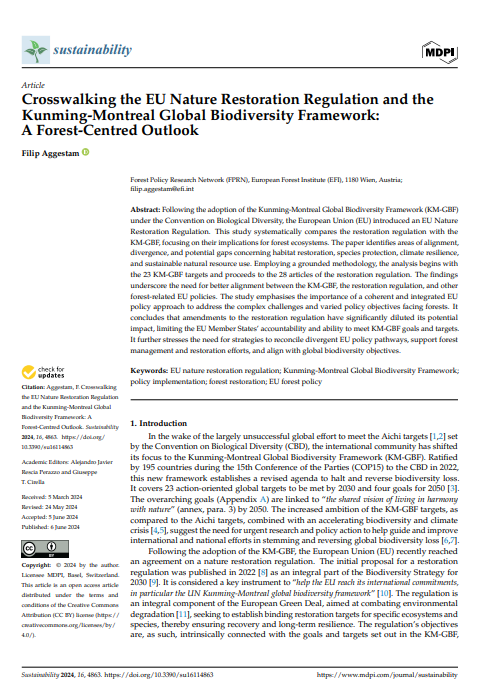Bridging biodiversity frameworks: A comparative analysis of the EU Nature Restoration Regulation and the Kunming-Montreal Global Biodiversity Framework
The Kunming-Montreal Global Biodiversity Framework (KM-GBF), adopted in 2022, sets ambitious targets aimed at halting and reversing biodiversity loss by 2030. It outlines 23 global targets, including the conservation of at least 30% of land and sea areas and the reduction of pollution impacts. The EU has recently adopted the Nature Restoration Regulation as a key component of its Biodiversity Strategy for 2030, aiming to restore 20% of the EU's land and sea areas by 2030. It focuses on specific ecosystems, including forests, wetlands, and marine environments.
My recent crosswalk reveals significant areas of alignment between the two frameworks. Both emphasize habitat restoration, species protection, and sustainable resource use. However, there are notable differences. The KM-GBF is broad and global, focusing on biodiversity integration across sectors, while the EU regulation is more specific and regionally focused, detailing precise restoration measures and monitoring requirements.
For forest ecosystems, the KM-GBF sets a general target for sustainable forest management. In contrast, the EU regulation specifies restoration actions, such as planting three billion additional trees by 2030 and enhancing forest connectivity. If implemented effectively, these ambitious actions can significantly contribute to the restoration and conservation of our forests.
However, the EU regulation’s amendments, which reduced the original restoration target from 30% to 20% and changed binding commitments to aims, dilute its potential impact and alignment with the KM-GBF.
Challenges and synergies in forest restoration
Forests play a crucial role in biodiversity conservation and climate resilience. The EU Nature Restoration Regulation’s focus on forest ecosystems includes measures for enhancing biodiversity, such as increasing deadwood and improving forest structure. However, conflicts arise with other policy objectives, such as the Renewable Energy Directive, which promotes bioenergy from forest biomass, potentially undermining conservation efforts. This underscores the urgent need to address these conflicts and find a balanced approach that respects all policy objectives. Moreover, the regulation acknowledges the need to remove certain forest areas to restore original habitats like grasslands and wetlands. This presents a trade-off between maintaining forest cover for carbon sequestration and restoring biodiversity-rich ecosystems.
While both frameworks offer complementary approaches, aligning their goals/targets and ensuring strong implementation mechanisms are crucial for meaningful progress in forest restoration and broader conservation efforts. This includes addressing policy conflicts, ensuring binding commitments, and enhancing member states’ accountability.
Dive into the complete analysis here or read a bit more on my post at the resilience blog.
